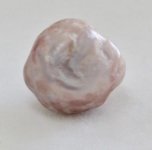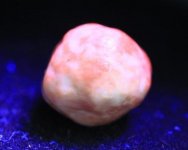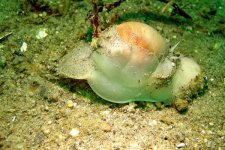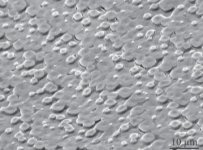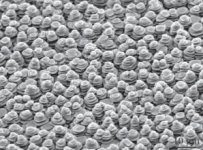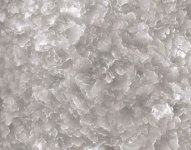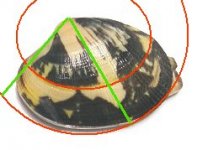
Douglas: That appears as they do locally. It's the larger of the snail species and is in the greatest numbers, so chances are it's the species we seek. I'll need to rummage through some boxes to find those blisters for UV fluorescence and photos.
Blaire: Identifying from photos is undoubtedly guess work, but there are few questions I ask myself on presentation.
Very often I look at what I don't see. I've seen numerous pearls from pectenidae (scallops) and almost every time they present with a "dipped in honey" surface, but with dimples much like a golf ball, and less so... the moon which would have a sharper line at the ridge of the crater. You almost never see this in freshwater pearls or most naturals (which tend to be over-mature). Calcite can occur two ways. One by lay up and the other by reversion.
High quality cultured pearls present this way. They're harvested post juvenile growth before calcite occludes the surface. Calcification is extended in clams and reduced in scallops. To the naked eye these are discernible features. Even at early stages of growth, clam pearls although nacreous are markedly calcitic. Many over-mature scallop pearls tend to remain clear at the surface. This is likely due to the age groups of the species themselves. Clams live about 6-7 years while scallops can attain much higher, upwards of 80 years has been described in rock scallops.
So no, I'm not suggesting foliated calcite in the presence of terraced aragonite insomuch as randomly ordered calcite whether by nature, senescence or molecular changes over time.
This topic is the crux of the current work that Ana and I are currently up to in the lab. It all started when she posed the question "If mussel shells appear blue, then where are the blue or green pearls?" Had she not asked "green", I might have missed her point, but immediately sought a solution in rock oysters (Pododesmus macrochisma), because the shells are markedly green.
I'm still waiting on the images from the SEM, but we're certain podos are foliated calcite. The real beauty of this particular species is the marked distinction in pigmentation, which is seasonally, hormonally controlled. There is no in between. Either it's green or it's perfectly clear and the transition is quick. We are examining very closely that margin to determine how the nacre is modified. Incidentally, I don't just theorize this in pearls. It is a feature I see on the outside of latticed shell structures. I've posted an image of a manila clam (Venerupis philipinarium) to help explain this. It's a three year old specimen. Ignoring the umbo we see growth in years two and three. Looking at the triangle between green and red lines we see a distinct pattern involving changes in pigmentation that are nearly replicated in consecutive years. It's really difficult to observe nacreous modifications on these shells because of calcite obscuring the views, whereas podo pearls, it's almost non-existent. By the way, pearl oysters, mussels (fresh or salt) and scallops are latticed structures. Many gastropods are too, but some are not, including Lewis's Moon Snail, and supports Douglas' observation which "seemed calcitic and aragonitic in nature".
The very best part of this research is I'm quite certain we'll determine markers that will distinguish fresh and saltwater pearls as well pointing toward certain species.

